Biggers, AR Map & Demographics
Biggers Map
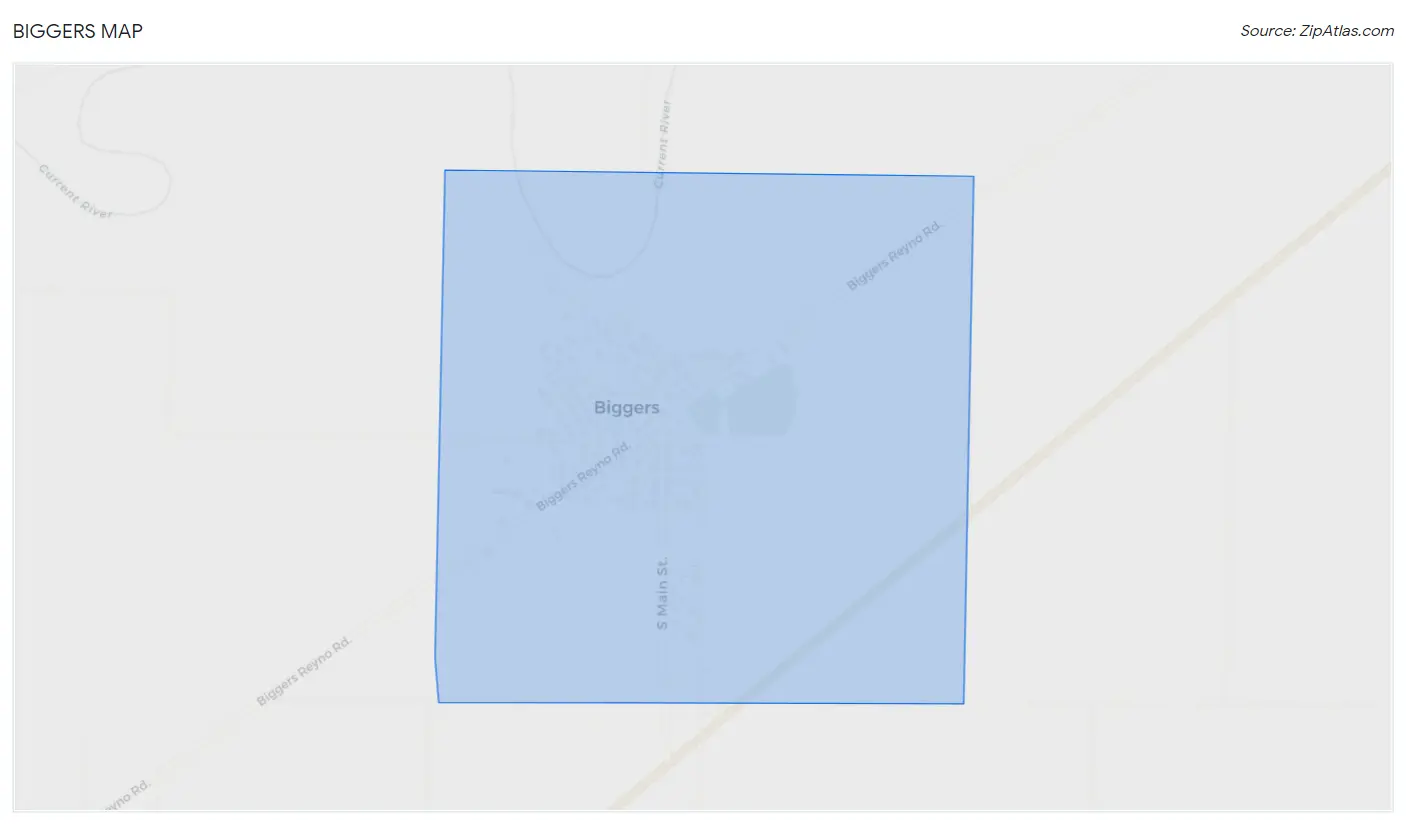
Biggers Overview
$22,250
PER CAPITA INCOME
$66,250
AVG FAMILY INCOME
7.1%
WAGE / INCOME GAP [ % ]
92.9¢/ $1
WAGE / INCOME GAP [ $ ]
0.37
INEQUALITY / GINI INDEX
466
TOTAL POPULATION
216
MALE POPULATION
250
FEMALE POPULATION
86.40
MALES / 100 FEMALES
115.74
FEMALES / 100 MALES
39.7
MEDIAN AGE
3.2
AVG FAMILY SIZE
2.7
AVG HOUSEHOLD SIZE
197
LABOR FORCE [ PEOPLE ]
52.7%
PERCENT IN LABOR FORCE
9.1%
UNEMPLOYMENT RATE
Biggers Zip Codes
Biggers Area Codes
Income in Biggers
Income Overview in Biggers
| Characteristic | Number | Measure |
| Per Capita Income | 466 | $22,250 |
| Median Family Income | 125 | $66,250 |
| Mean Family Income | 125 | $61,761 |
| Median Household Income | 170 | $0 |
| Mean Household Income | 170 | $52,828 |
| Income Deficit | 125 | $0 |
| Wage / Income Gap (%) | 466 | 7.06% |
| Wage / Income Gap ($) | 466 | 92.94¢ per $1 |
| Gini / Inequality Index | 466 | 0.37 |
Earnings by Sex in Biggers
Average Earnings in Biggers are $24,205, $25,804 for men and $23,981 for women, a difference of 7.1%.

| Sex | Number | Average Earnings |
| Male | 89 (45.6%) | $25,804 |
| Female | 106 (54.4%) | $23,981 |
| Total | 195 (100.0%) | $24,205 |
Earnings by Sex by Income Bracket in Biggers
The most common earnings brackets in Biggers are $2,500 to $4,999 for men (19 | 21.3%) and $22,500 to $24,999 for women (54 | 50.9%).
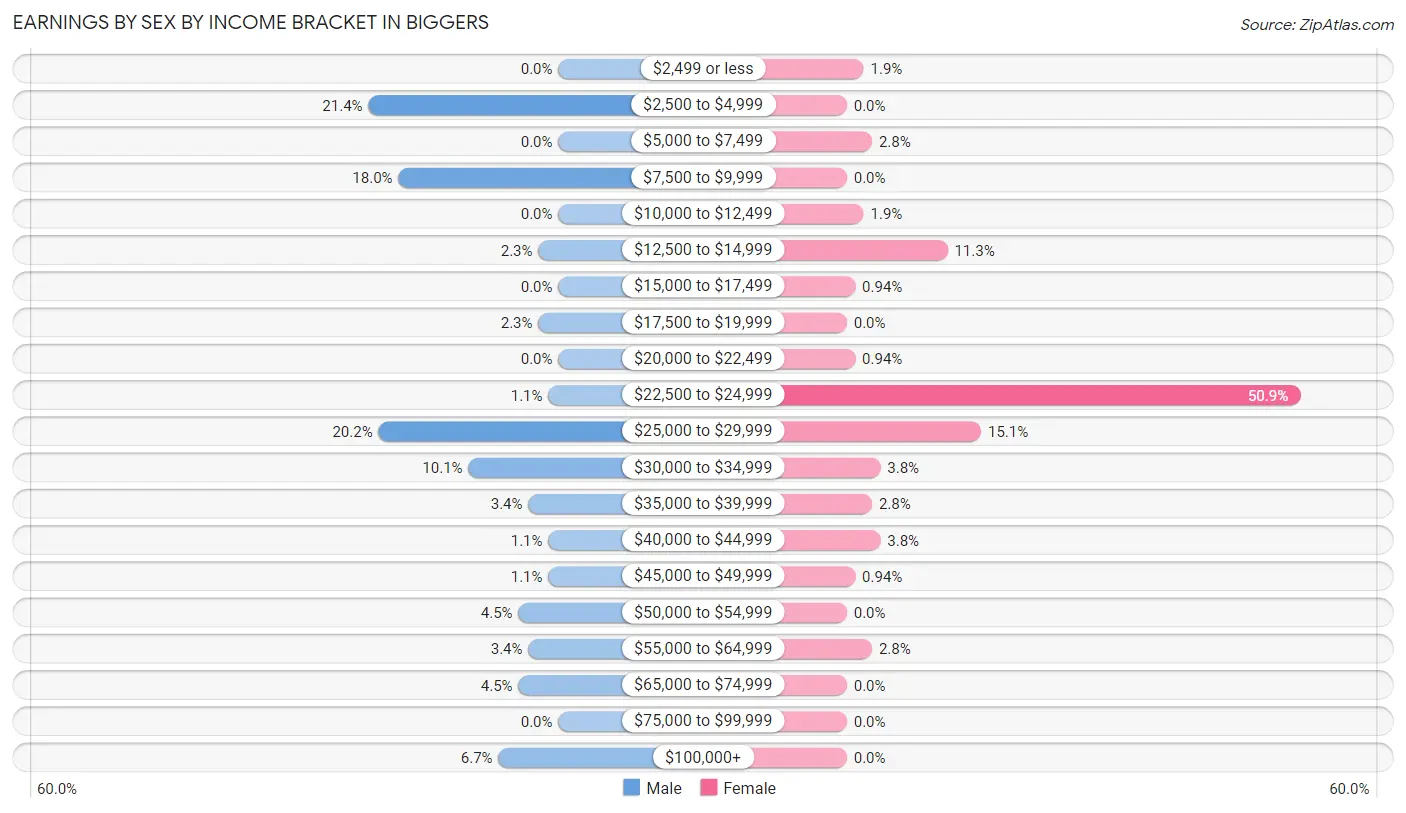
| Income | Male | Female |
| $2,499 or less | 0 (0.0%) | 2 (1.9%) |
| $2,500 to $4,999 | 19 (21.3%) | 0 (0.0%) |
| $5,000 to $7,499 | 0 (0.0%) | 3 (2.8%) |
| $7,500 to $9,999 | 16 (18.0%) | 0 (0.0%) |
| $10,000 to $12,499 | 0 (0.0%) | 2 (1.9%) |
| $12,500 to $14,999 | 2 (2.2%) | 12 (11.3%) |
| $15,000 to $17,499 | 0 (0.0%) | 1 (0.9%) |
| $17,500 to $19,999 | 2 (2.2%) | 0 (0.0%) |
| $20,000 to $22,499 | 0 (0.0%) | 1 (0.9%) |
| $22,500 to $24,999 | 1 (1.1%) | 54 (50.9%) |
| $25,000 to $29,999 | 18 (20.2%) | 16 (15.1%) |
| $30,000 to $34,999 | 9 (10.1%) | 4 (3.8%) |
| $35,000 to $39,999 | 3 (3.4%) | 3 (2.8%) |
| $40,000 to $44,999 | 1 (1.1%) | 4 (3.8%) |
| $45,000 to $49,999 | 1 (1.1%) | 1 (0.9%) |
| $50,000 to $54,999 | 4 (4.5%) | 0 (0.0%) |
| $55,000 to $64,999 | 3 (3.4%) | 3 (2.8%) |
| $65,000 to $74,999 | 4 (4.5%) | 0 (0.0%) |
| $75,000 to $99,999 | 0 (0.0%) | 0 (0.0%) |
| $100,000+ | 6 (6.7%) | 0 (0.0%) |
| Total | 89 (100.0%) | 106 (100.0%) |
Earnings by Sex by Educational Attainment in Biggers

| Educational Attainment | Male Income | Female Income |
| Less than High School | - | - |
| High School Diploma | $31,667 | $23,773 |
| College or Associate's Degree | - | - |
| Bachelor's Degree | - | - |
| Graduate Degree | - | - |
| Total | - | - |
Family Income in Biggers
Family Income Brackets in Biggers
According to the Biggers family income data, there are 38 families falling into the $50,000 to $74,999 income range, which is the most common income bracket and makes up 30.4% of all families. Conversely, the less than $10,000 income bracket is the least frequent group with only 2 families (1.6%) belonging to this category.

| Income Bracket | # Families | % Families |
| Less than $10,000 | 2 | 1.6% |
| $10,000 to $14,999 | 12 | 9.6% |
| $15,000 to $24,999 | 9 | 7.2% |
| $25,000 to $34,999 | 22 | 17.6% |
| $35,000 to $49,999 | 7 | 5.6% |
| $50,000 to $74,999 | 38 | 30.4% |
| $75,000 to $99,999 | 27 | 21.6% |
| $100,000 to $149,999 | 3 | 2.4% |
| $150,000 to $199,999 | 3 | 2.4% |
| $200,000+ | 2 | 1.6% |
Family Income by Famaliy Size in Biggers
3-person families (31 | 24.8%) account for the highest median family income in Biggers with $90,903 per family, while 2-person families (50 | 40.0%) have the highest median income of $34,271 per family member.

| Income Bracket | # Families | Median Income |
| 2-Person Families | 50 (40.0%) | $68,542 |
| 3-Person Families | 31 (24.8%) | $90,903 |
| 4-Person Families | 10 (8.0%) | $40,833 |
| 5-Person Families | 34 (27.2%) | $31,250 |
| 6-Person Families | 0 (0.0%) | $0 |
| 7+ Person Families | 0 (0.0%) | $0 |
| Total | 125 (100.0%) | $66,250 |
Family Income by Number of Earners in Biggers
The median family income in Biggers is $66,250, with families comprising 1 earner (79) having the highest median family income of $68,239, while families with no earners (22) have the lowest median family income of $26,250, accounting for 63.2% and 17.6% of families, respectively.

| Number of Earners | # Families | Median Income |
| No Earners | 22 (17.6%) | $26,250 |
| 1 Earner | 79 (63.2%) | $68,239 |
| 2 Earners | 12 (9.6%) | $65,833 |
| 3+ Earners | 12 (9.6%) | $64,375 |
| Total | 125 (100.0%) | $66,250 |
Household Income in Biggers
Household Income Brackets in Biggers
With 43 households falling in the category, the $50,000 to $74,999 income range is the most frequent in Biggers, accounting for 25.3% of all households. In contrast, only 2 households (1.2%) fall into the less than $10,000 income bracket, making it the least populous group.

| Income Bracket | # Households | % Households |
| Less than $10,000 | 2 | 1.2% |
| $10,000 to $14,999 | 10 | 5.9% |
| $15,000 to $24,999 | 39 | 22.9% |
| $25,000 to $34,999 | 31 | 18.2% |
| $35,000 to $49,999 | 10 | 5.9% |
| $50,000 to $74,999 | 43 | 25.3% |
| $75,000 to $99,999 | 27 | 15.9% |
| $100,000 to $149,999 | 3 | 1.8% |
| $150,000 to $199,999 | 3 | 1.8% |
| $200,000+ | 2 | 1.2% |
Household Income by Householder Age in Biggers
The median household income in Biggers is $0, with the highest median household income of $68,594 found in the 65+ years age bracket for the primary householder. A total of 85 households (50.0%) fall into this category. Meanwhile, the 15 to 24 years age bracket for the primary householder has the lowest median household income of $25,714, with 14 households (8.2%) in this group.

| Income Bracket | # Households | Median Income |
| 15 to 24 Years | 14 (8.2%) | $25,714 |
| 25 to 44 Years | 44 (25.9%) | $31,806 |
| 45 to 64 Years | 27 (15.9%) | $31,250 |
| 65+ Years | 85 (50.0%) | $68,594 |
| Total | 170 (100.0%) | $0 |
Poverty in Biggers
Income Below Poverty by Sex and Age in Biggers
With 38.9% poverty level for males and 30.4% for females among the residents of Biggers, under 5 year old males and 5 year old females are the most vulnerable to poverty, with 29 males (100.0%) and 9 females (100.0%) in their respective age groups living below the poverty level.
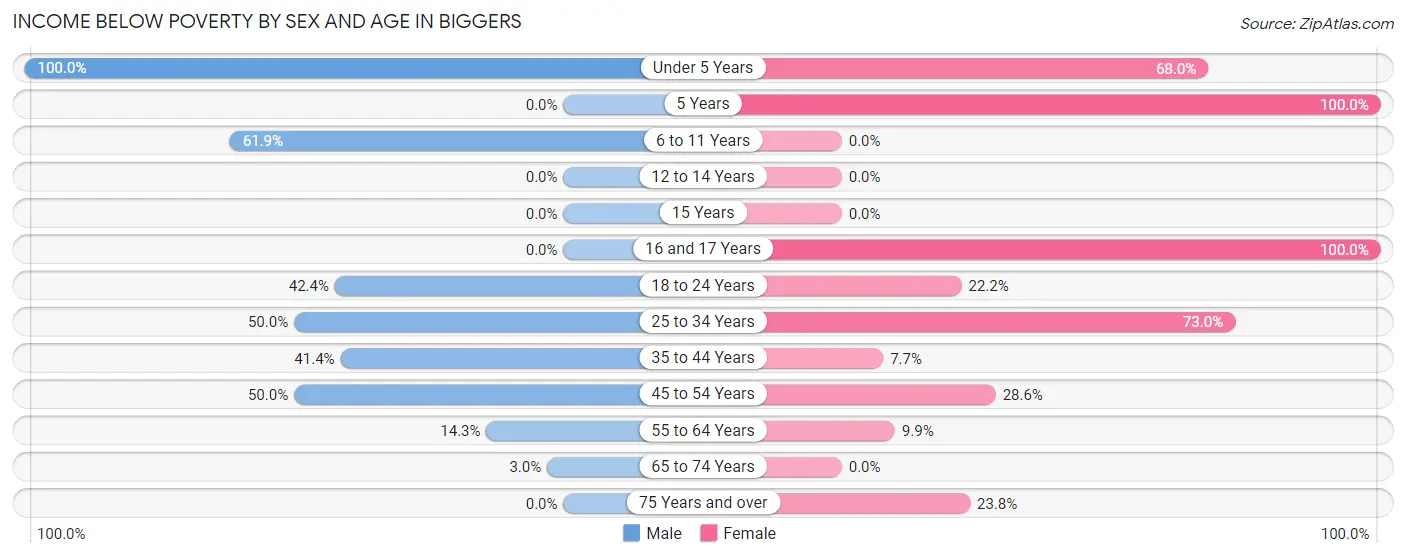
| Age Bracket | Male | Female |
| Under 5 Years | 29 (100.0%) | 17 (68.0%) |
| 5 Years | 0 (0.0%) | 9 (100.0%) |
| 6 to 11 Years | 13 (61.9%) | 0 (0.0%) |
| 12 to 14 Years | 0 (0.0%) | 0 (0.0%) |
| 15 Years | 0 (0.0%) | 0 (0.0%) |
| 16 and 17 Years | 0 (0.0%) | 4 (100.0%) |
| 18 to 24 Years | 14 (42.4%) | 4 (22.2%) |
| 25 to 34 Years | 11 (50.0%) | 27 (73.0%) |
| 35 to 44 Years | 12 (41.4%) | 1 (7.7%) |
| 45 to 54 Years | 2 (50.0%) | 2 (28.6%) |
| 55 to 64 Years | 2 (14.3%) | 7 (9.9%) |
| 65 to 74 Years | 1 (3.0%) | 0 (0.0%) |
| 75 Years and over | 0 (0.0%) | 5 (23.8%) |
| Total | 84 (38.9%) | 76 (30.4%) |
Income Above Poverty by Sex and Age in Biggers
According to the poverty statistics in Biggers, males aged 16 and 17 years and females aged 6 to 11 years are the age groups that are most secure financially, with 100.0% of males and 100.0% of females in these age groups living above the poverty line.
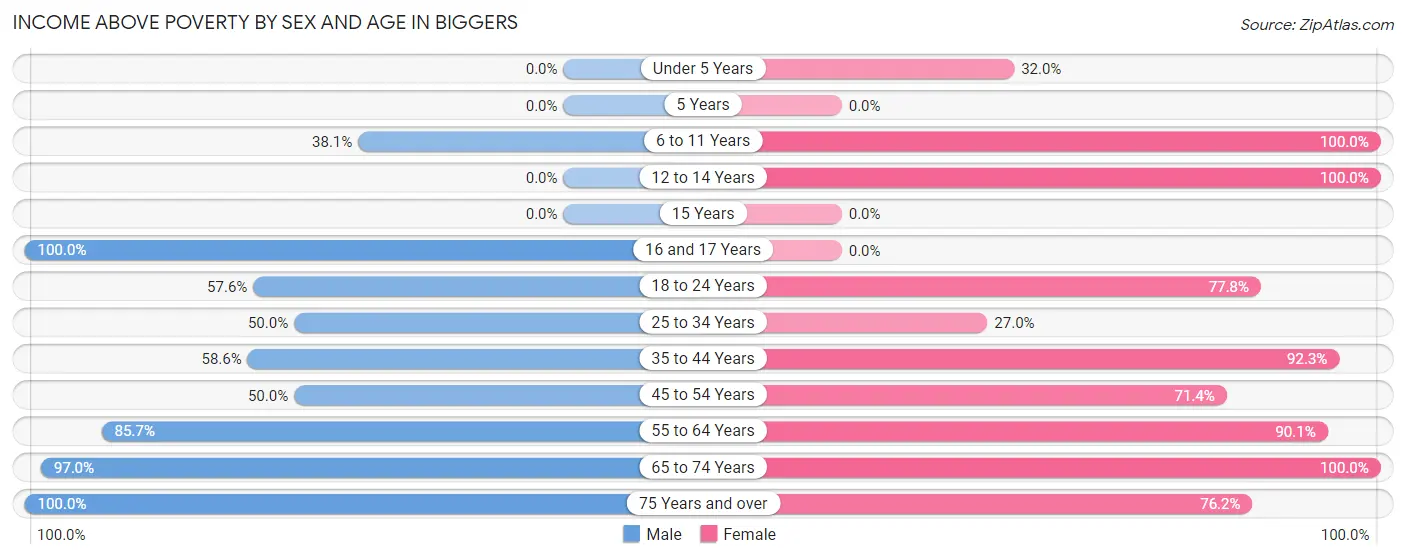
| Age Bracket | Male | Female |
| Under 5 Years | 0 (0.0%) | 8 (32.0%) |
| 5 Years | 0 (0.0%) | 0 (0.0%) |
| 6 to 11 Years | 8 (38.1%) | 6 (100.0%) |
| 12 to 14 Years | 0 (0.0%) | 2 (100.0%) |
| 15 Years | 0 (0.0%) | 0 (0.0%) |
| 16 and 17 Years | 1 (100.0%) | 0 (0.0%) |
| 18 to 24 Years | 19 (57.6%) | 14 (77.8%) |
| 25 to 34 Years | 11 (50.0%) | 10 (27.0%) |
| 35 to 44 Years | 17 (58.6%) | 12 (92.3%) |
| 45 to 54 Years | 2 (50.0%) | 5 (71.4%) |
| 55 to 64 Years | 12 (85.7%) | 64 (90.1%) |
| 65 to 74 Years | 32 (97.0%) | 37 (100.0%) |
| 75 Years and over | 30 (100.0%) | 16 (76.2%) |
| Total | 132 (61.1%) | 174 (69.6%) |
Income Below Poverty Among Married-Couple Families in Biggers
The poverty statistics for married-couple families in Biggers show that 23.1% or 21 of the total 91 families live below the poverty line. Families with 3 or 4 children have the highest poverty rate of 100.0%, comprising of 18 families. On the other hand, families with 1 or 2 children have the lowest poverty rate of 0.0%, which includes 0 families.

| Children | Above Poverty | Below Poverty |
| No Children | 63 (95.5%) | 3 (4.5%) |
| 1 or 2 Children | 7 (100.0%) | 0 (0.0%) |
| 3 or 4 Children | 0 (0.0%) | 18 (100.0%) |
| 5 or more Children | 0 (0.0%) | 0 (0.0%) |
| Total | 70 (76.9%) | 21 (23.1%) |
Income Below Poverty Among Single-Parent Households in Biggers
According to the poverty data in Biggers, 100.0% or 2 single-father households and 50.0% or 16 single-mother households are living below the poverty line. Among single-father households, those with no children have the highest poverty rate, with 2 households (100.0%) experiencing poverty. Likewise, among single-mother households, those with 3 or 4 children have the highest poverty rate, with 9 households (75.0%) falling below the poverty line.

| Children | Single Father | Single Mother |
| No Children | 2 (100.0%) | 2 (33.3%) |
| 1 or 2 Children | 0 (0.0%) | 5 (35.7%) |
| 3 or 4 Children | 0 (0.0%) | 9 (75.0%) |
| 5 or more Children | 0 (0.0%) | 0 (0.0%) |
| Total | 2 (100.0%) | 16 (50.0%) |
Income Below Poverty Among Married-Couple vs Single-Parent Households in Biggers
The poverty data for Biggers shows that 21 of the married-couple family households (23.1%) and 18 of the single-parent households (52.9%) are living below the poverty level. Within the married-couple family households, those with 3 or 4 children have the highest poverty rate, with 18 households (100.0%) falling below the poverty line. Among the single-parent households, those with 3 or 4 children have the highest poverty rate, with 9 household (75.0%) living below poverty.

| Children | Married-Couple Families | Single-Parent Households |
| No Children | 3 (4.5%) | 4 (50.0%) |
| 1 or 2 Children | 0 (0.0%) | 5 (35.7%) |
| 3 or 4 Children | 18 (100.0%) | 9 (75.0%) |
| 5 or more Children | 0 (0.0%) | 0 (0.0%) |
| Total | 21 (23.1%) | 18 (52.9%) |
Race in Biggers
The most populous races in Biggers are White / Caucasian (383 | 82.2%), Two or more Races (81 | 17.4%), and Hispanic or Latino (52 | 11.2%).

| Race | # Population | % Population |
| Asian | 0 | 0.0% |
| Black / African American | 2 | 0.4% |
| Hawaiian / Pacific | 0 | 0.0% |
| Hispanic or Latino | 52 | 11.2% |
| Native / Alaskan | 0 | 0.0% |
| White / Caucasian | 383 | 82.2% |
| Two or more Races | 81 | 17.4% |
| Some other Race | 0 | 0.0% |
| Total | 466 | 100.0% |
Ancestry in Biggers
The most populous ancestries reported in Biggers are Irish (56 | 12.0%), Spanish (52 | 11.2%), English (31 | 6.7%), German (28 | 6.0%), and American (23 | 4.9%), together accounting for 40.8% of all Biggers residents.
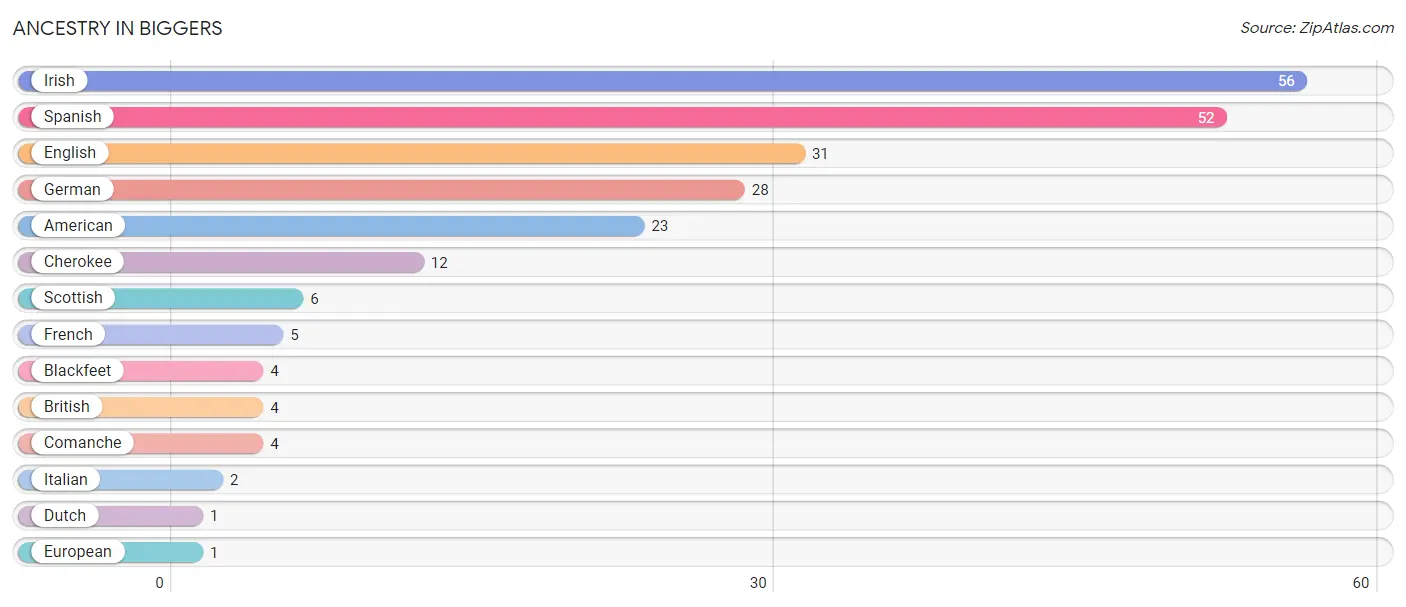
| Ancestry | # Population | % Population |
| American | 23 | 4.9% |
| Blackfeet | 4 | 0.9% |
| British | 4 | 0.9% |
| Cherokee | 12 | 2.6% |
| Comanche | 4 | 0.9% |
| Dutch | 1 | 0.2% |
| English | 31 | 6.7% |
| European | 1 | 0.2% |
| French | 5 | 1.1% |
| German | 28 | 6.0% |
| Irish | 56 | 12.0% |
| Italian | 2 | 0.4% |
| Scottish | 6 | 1.3% |
| Spanish | 52 | 11.2% | View All 14 Rows |
Immigrants in Biggers

| Immigration Origin | # Population | % Population | View All 0 Rows |
Sex and Age in Biggers
Sex and Age in Biggers
The most populous age groups in Biggers are Under 5 Years (29 | 13.4%) for men and 60 to 64 Years (56 | 22.4%) for women.
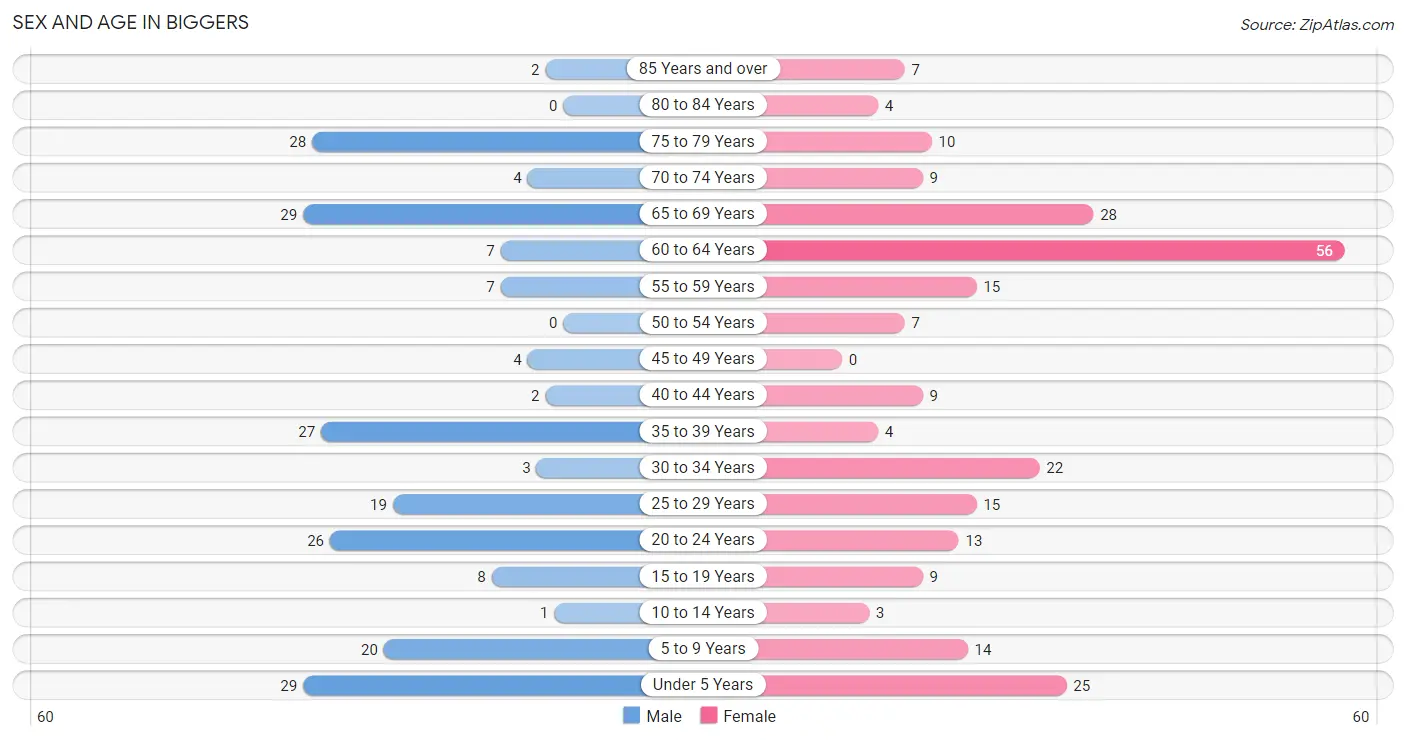
| Age Bracket | Male | Female |
| Under 5 Years | 29 (13.4%) | 25 (10.0%) |
| 5 to 9 Years | 20 (9.3%) | 14 (5.6%) |
| 10 to 14 Years | 1 (0.5%) | 3 (1.2%) |
| 15 to 19 Years | 8 (3.7%) | 9 (3.6%) |
| 20 to 24 Years | 26 (12.0%) | 13 (5.2%) |
| 25 to 29 Years | 19 (8.8%) | 15 (6.0%) |
| 30 to 34 Years | 3 (1.4%) | 22 (8.8%) |
| 35 to 39 Years | 27 (12.5%) | 4 (1.6%) |
| 40 to 44 Years | 2 (0.9%) | 9 (3.6%) |
| 45 to 49 Years | 4 (1.8%) | 0 (0.0%) |
| 50 to 54 Years | 0 (0.0%) | 7 (2.8%) |
| 55 to 59 Years | 7 (3.2%) | 15 (6.0%) |
| 60 to 64 Years | 7 (3.2%) | 56 (22.4%) |
| 65 to 69 Years | 29 (13.4%) | 28 (11.2%) |
| 70 to 74 Years | 4 (1.8%) | 9 (3.6%) |
| 75 to 79 Years | 28 (13.0%) | 10 (4.0%) |
| 80 to 84 Years | 0 (0.0%) | 4 (1.6%) |
| 85 Years and over | 2 (0.9%) | 7 (2.8%) |
| Total | 216 (100.0%) | 250 (100.0%) |
Families and Households in Biggers
Median Family Size in Biggers
The median family size in Biggers is 3.21 persons per family, with single female/mother families (32 | 25.6%) accounting for the largest median family size of 4 persons per family. On the other hand, single male/father families (2 | 1.6%) represent the smallest median family size with 2.50 persons per family.

| Family Type | # Families | Family Size |
| Married-Couple | 91 (72.8%) | 2.95 |
| Single Male/Father | 2 (1.6%) | 2.50 |
| Single Female/Mother | 32 (25.6%) | 4.00 |
| Total Families | 125 (100.0%) | 3.21 |
Median Household Size in Biggers
The median household size in Biggers is 2.74 persons per household, with single female/mother households (32 | 18.8%) accounting for the largest median household size of 4.56 persons per household. non-family households (45 | 26.5%) represent the smallest median household size with 1.04 persons per household.

| Household Type | # Households | Household Size |
| Married-Couple | 91 (53.5%) | 2.95 |
| Single Male/Father | 2 (1.2%) | 2.50 |
| Single Female/Mother | 32 (18.8%) | 4.56 |
| Non-family | 45 (26.5%) | 1.04 |
| Total Households | 170 (100.0%) | 2.74 |
Household Size by Marriage Status in Biggers
Out of a total of 170 households in Biggers, 125 (73.5%) are family households, while 45 (26.5%) are nonfamily households. The most numerous type of family households are 2-person households, comprising 50, and the most common type of nonfamily households are 1-person households, comprising 43.

| Household Size | Family Households | Nonfamily Households |
| 1-Person Households | - | 43 (25.3%) |
| 2-Person Households | 50 (29.4%) | 2 (1.2%) |
| 3-Person Households | 31 (18.2%) | 0 (0.0%) |
| 4-Person Households | 10 (5.9%) | 0 (0.0%) |
| 5-Person Households | 18 (10.6%) | 0 (0.0%) |
| 6-Person Households | 16 (9.4%) | 0 (0.0%) |
| 7+ Person Households | 0 (0.0%) | 0 (0.0%) |
| Total | 125 (73.5%) | 45 (26.5%) |
Female Fertility in Biggers
Fertility by Age in Biggers
Average fertility rate in Biggers is 181.0 births per 1,000 women. Women in the age bracket of 15 to 19 years have the highest fertility rate with 556.0 births per 1,000 women. Women in the age bracket of 20 to 34 years acount for 61.5% of all women with births.

| Age Bracket | Women with Births | Births / 1,000 Women |
| 15 to 19 years | 5 (38.5%) | 556.0 |
| 20 to 34 years | 8 (61.5%) | 160.0 |
| 35 to 50 years | 0 (0.0%) | 0.0 |
| Total | 13 (100.0%) | 181.0 |
Fertility by Age by Marriage Status in Biggers

| Age Bracket | Married | Unmarried |
| 15 to 19 years | 0 (0.0%) | 5 (100.0%) |
| 20 to 34 years | 0 (0.0%) | 8 (100.0%) |
| 35 to 50 years | 0 (0.0%) | 0 (0.0%) |
| Total | 0 (0.0%) | 13 (100.0%) |
Fertility by Education in Biggers
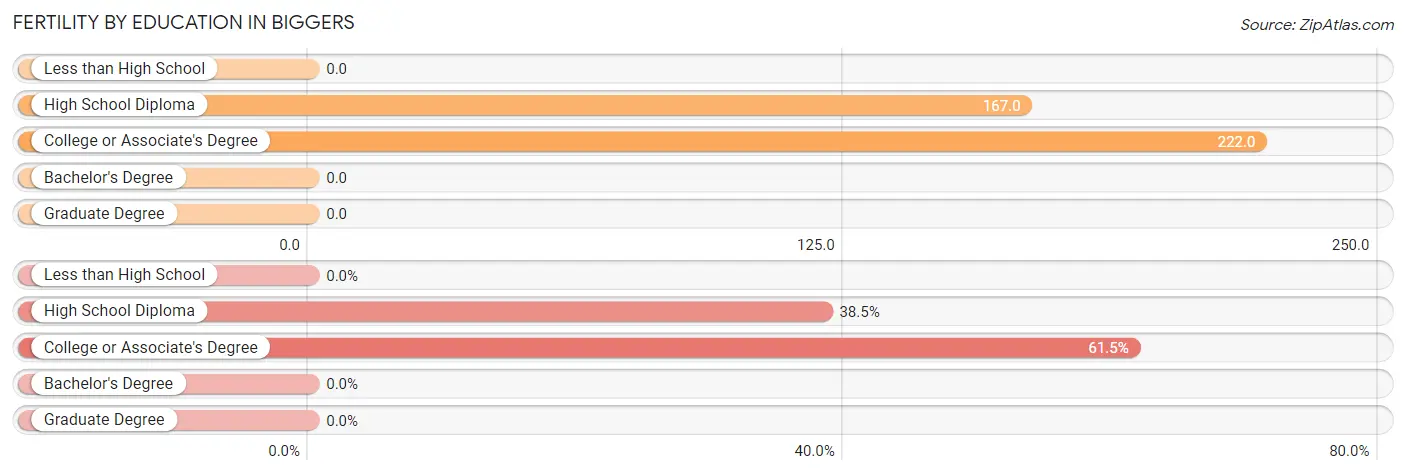
| Educational Attainment | Women with Births | Births / 1,000 Women |
| Less than High School | 0 (0.0%) | 0.0 |
| High School Diploma | 5 (38.5%) | 167.0 |
| College or Associate's Degree | 8 (61.5%) | 222.0 |
| Bachelor's Degree | 0 (0.0%) | 0.0 |
| Graduate Degree | 0 (0.0%) | 0.0 |
| Total | 13 (100.0%) | 181.0 |
Fertility by Education by Marriage Status in Biggers

| Educational Attainment | Married | Unmarried |
| Less than High School | 0 (0.0%) | 0 (0.0%) |
| High School Diploma | 0 (0.0%) | 5 (100.0%) |
| College or Associate's Degree | 0 (0.0%) | 8 (100.0%) |
| Bachelor's Degree | 0 (0.0%) | 0 (0.0%) |
| Graduate Degree | 0 (0.0%) | 0 (0.0%) |
| Total | 0 (0.0%) | 13 (100.0%) |
Employment Characteristics in Biggers
Employment by Class of Employer in Biggers
Among the 179 employed individuals in Biggers, private company employees (143 | 79.9%), not-for-profit organizations (23 | 12.9%), and self-employed (not incorporated) (5 | 2.8%) make up the most common classes of employment.

| Employer Class | # Employees | % Employees |
| Private Company Employees | 143 | 79.9% |
| Self-Employed (Incorporated) | 3 | 1.7% |
| Self-Employed (Not Incorporated) | 5 | 2.8% |
| Not-for-profit Organizations | 23 | 12.9% |
| Local Government Employees | 3 | 1.7% |
| State Government Employees | 1 | 0.6% |
| Federal Government Employees | 1 | 0.6% |
| Unpaid Family Workers | 0 | 0.0% |
| Total | 179 | 100.0% |
Employment Status by Age in Biggers
According to the labor force statistics for Biggers, out of the total population over 16 years of age (374), 52.7% or 197 individuals are in the labor force, with 9.1% or 18 of them unemployed. The age group with the highest labor force participation rate is 25 to 29 years, with 100.0% or 34 individuals in the labor force. Within the labor force, the 25 to 29 years age range has the highest percentage of unemployed individuals, with 44.1% or 15 of them being unemployed.

| Age Bracket | In Labor Force | Unemployed |
| 16 to 19 Years | 0 (0.0%) | 0 (0.0%) |
| 20 to 24 Years | 33 (84.6%) | 2 (6.1%) |
| 25 to 29 Years | 34 (100.0%) | 15 (44.1%) |
| 30 to 34 Years | 6 (24.0%) | 0 (0.0%) |
| 35 to 44 Years | 26 (61.9%) | 0 (0.0%) |
| 45 to 54 Years | 6 (54.5%) | 0 (0.0%) |
| 55 to 59 Years | 10 (45.5%) | 1 (10.0%) |
| 60 to 64 Years | 58 (92.1%) | 0 (0.0%) |
| 65 to 74 Years | 24 (34.3%) | 0 (0.0%) |
| 75 Years and over | 0 (0.0%) | 0 (0.0%) |
| Total | 197 (52.7%) | 18 (9.1%) |
Employment Status by Educational Attainment in Biggers
According to labor force statistics for Biggers, 71.1% of individuals (140) out of the total population between 25 and 64 years of age (197) are in the labor force, with 11.4% or 16 of them being unemployed. The group with the highest labor force participation rate are those with the educational attainment of bachelor's degree or higher, with 100.0% or 7 individuals in the labor force. Within the labor force, individuals with college / associate degree education have the highest percentage of unemployment, with 30.0% or 15 of them being unemployed.

| Educational Attainment | In Labor Force | Unemployed |
| Less than High School | 7 (58.3%) | 2 (14.3%) |
| High School Diploma | 76 (73.1%) | 0 (0.0%) |
| College / Associate Degree | 50 (67.6%) | 22 (30.0%) |
| Bachelor's Degree or higher | 7 (100.0%) | 0 (0.0%) |
| Total | 140 (71.1%) | 22 (11.4%) |
Employment Occupations by Sex in Biggers
Management, Business, Science and Arts Occupations
The most common Management, Business, Science and Arts occupations in Biggers are Community & Social Service (24 | 13.4%), Education, Arts & Media (18 | 10.1%), Business & Financial (8 | 4.5%), Legal Services & Support (4 | 2.2%), and Health Diagnosing & Treating (4 | 2.2%).
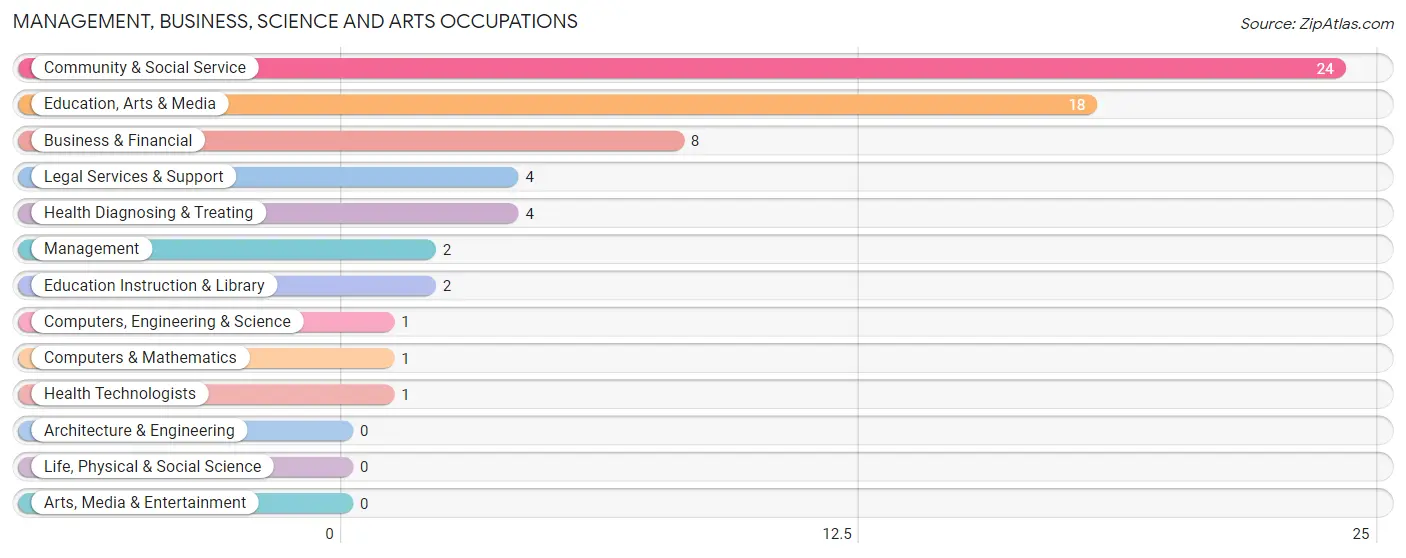
Management, Business, Science and Arts Occupations by Sex
Within the Management, Business, Science and Arts occupations in Biggers, the most male-oriented occupations are Education, Arts & Media (100.0%), Legal Services & Support (100.0%), and Community & Social Service (91.7%), while the most female-oriented occupations are Business & Financial (100.0%), Computers, Engineering & Science (100.0%), and Computers & Mathematics (100.0%).
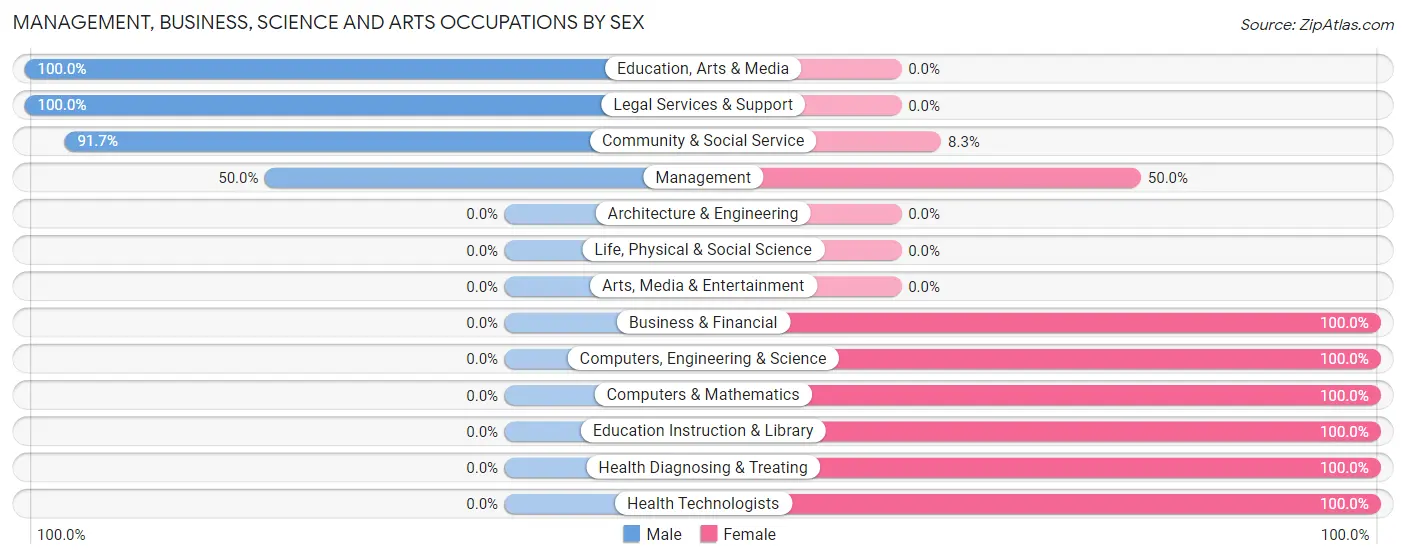
| Occupation | Male | Female |
| Management | 1 (50.0%) | 1 (50.0%) |
| Business & Financial | 0 (0.0%) | 8 (100.0%) |
| Computers, Engineering & Science | 0 (0.0%) | 1 (100.0%) |
| Computers & Mathematics | 0 (0.0%) | 1 (100.0%) |
| Architecture & Engineering | 0 (0.0%) | 0 (0.0%) |
| Life, Physical & Social Science | 0 (0.0%) | 0 (0.0%) |
| Community & Social Service | 22 (91.7%) | 2 (8.3%) |
| Education, Arts & Media | 18 (100.0%) | 0 (0.0%) |
| Legal Services & Support | 4 (100.0%) | 0 (0.0%) |
| Education Instruction & Library | 0 (0.0%) | 2 (100.0%) |
| Arts, Media & Entertainment | 0 (0.0%) | 0 (0.0%) |
| Health Diagnosing & Treating | 0 (0.0%) | 4 (100.0%) |
| Health Technologists | 0 (0.0%) | 1 (100.0%) |
| Total (Category) | 23 (59.0%) | 16 (41.0%) |
| Total (Overall) | 77 (43.0%) | 102 (57.0%) |
Services Occupations
The most common Services occupations in Biggers are Cleaning & Maintenance (11 | 6.1%), Healthcare Support (8 | 4.5%), Personal Care & Service (2 | 1.1%), and Food Preparation & Serving (1 | 0.6%).

Services Occupations by Sex

| Occupation | Male | Female |
| Healthcare Support | 0 (0.0%) | 8 (100.0%) |
| Security & Protection | 0 (0.0%) | 0 (0.0%) |
| Firefighting & Prevention | 0 (0.0%) | 0 (0.0%) |
| Law Enforcement | 0 (0.0%) | 0 (0.0%) |
| Food Preparation & Serving | 0 (0.0%) | 1 (100.0%) |
| Cleaning & Maintenance | 3 (27.3%) | 8 (72.7%) |
| Personal Care & Service | 0 (0.0%) | 2 (100.0%) |
| Total (Category) | 3 (13.6%) | 19 (86.4%) |
| Total (Overall) | 77 (43.0%) | 102 (57.0%) |
Sales and Office Occupations
The most common Sales and Office occupations in Biggers are Sales & Related (58 | 32.4%), and Office & Administration (9 | 5.0%).

Sales and Office Occupations by Sex

| Occupation | Male | Female |
| Sales & Related | 4 (6.9%) | 54 (93.1%) |
| Office & Administration | 3 (33.3%) | 6 (66.7%) |
| Total (Category) | 7 (10.4%) | 60 (89.5%) |
| Total (Overall) | 77 (43.0%) | 102 (57.0%) |
Natural Resources, Construction and Maintenance Occupations
The most common Natural Resources, Construction and Maintenance occupations in Biggers are Farming, Fishing & Forestry (11 | 6.1%), Construction & Extraction (7 | 3.9%), and Installation, Maintenance & Repair (1 | 0.6%).

Natural Resources, Construction and Maintenance Occupations by Sex

| Occupation | Male | Female |
| Farming, Fishing & Forestry | 11 (100.0%) | 0 (0.0%) |
| Construction & Extraction | 7 (100.0%) | 0 (0.0%) |
| Installation, Maintenance & Repair | 1 (100.0%) | 0 (0.0%) |
| Total (Category) | 19 (100.0%) | 0 (0.0%) |
| Total (Overall) | 77 (43.0%) | 102 (57.0%) |
Production, Transportation and Moving Occupations
The most common Production, Transportation and Moving occupations in Biggers are Production (14 | 7.8%), Material Moving (10 | 5.6%), and Transportation (8 | 4.5%).

Production, Transportation and Moving Occupations by Sex

| Occupation | Male | Female |
| Production | 14 (100.0%) | 0 (0.0%) |
| Transportation | 8 (100.0%) | 0 (0.0%) |
| Material Moving | 3 (30.0%) | 7 (70.0%) |
| Total (Category) | 25 (78.1%) | 7 (21.9%) |
| Total (Overall) | 77 (43.0%) | 102 (57.0%) |
Employment Industries by Sex in Biggers
Employment Industries in Biggers
The major employment industries in Biggers include Retail Trade (56 | 31.3%), Manufacturing (25 | 14.0%), Transportation & Warehousing (23 | 12.9%), Health Care & Social Assistance (17 | 9.5%), and Wholesale Trade (13 | 7.3%).
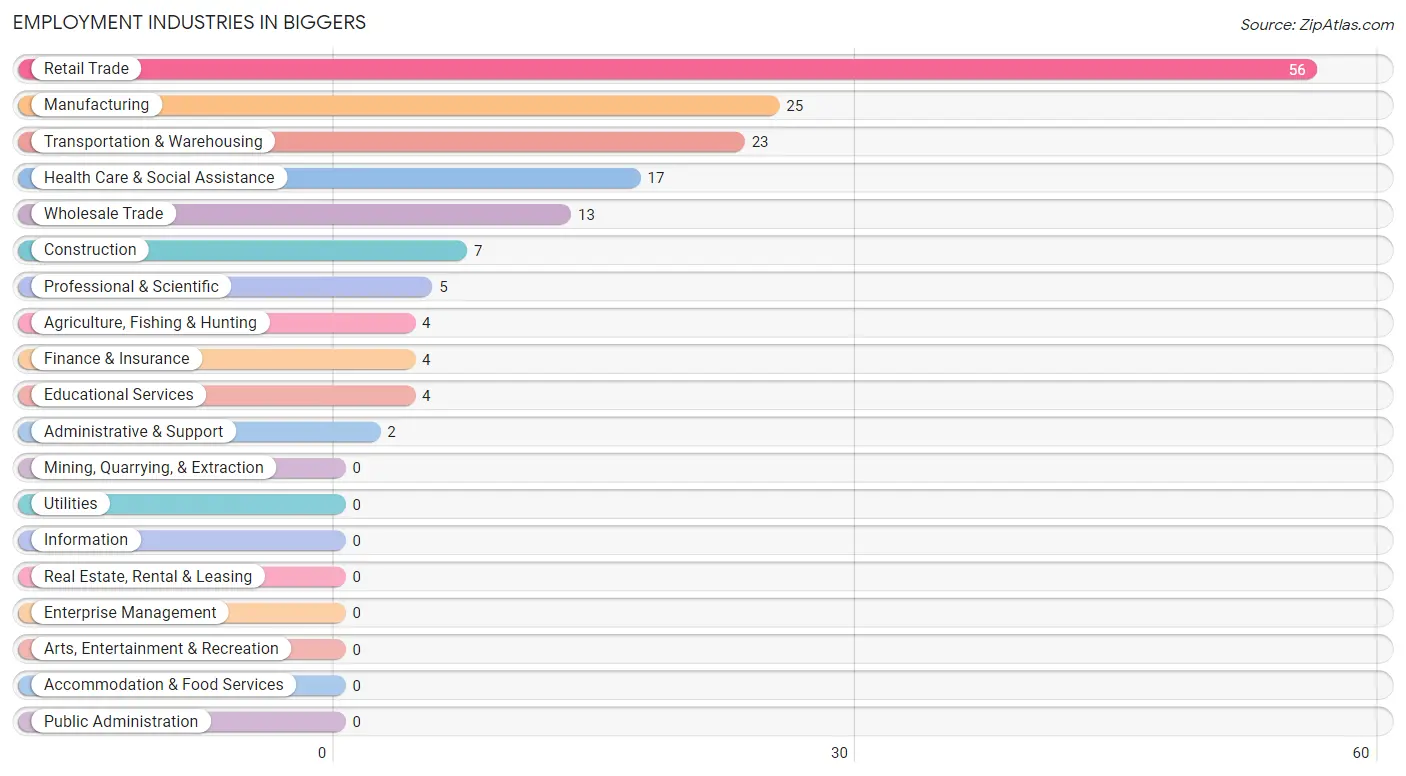
Employment Industries by Sex in Biggers
The Biggers industries that see more men than women are Construction (100.0%), Wholesale Trade (100.0%), and Finance & Insurance (100.0%), whereas the industries that tend to have a higher number of women are Educational Services (100.0%), Health Care & Social Assistance (100.0%), and Retail Trade (96.4%).
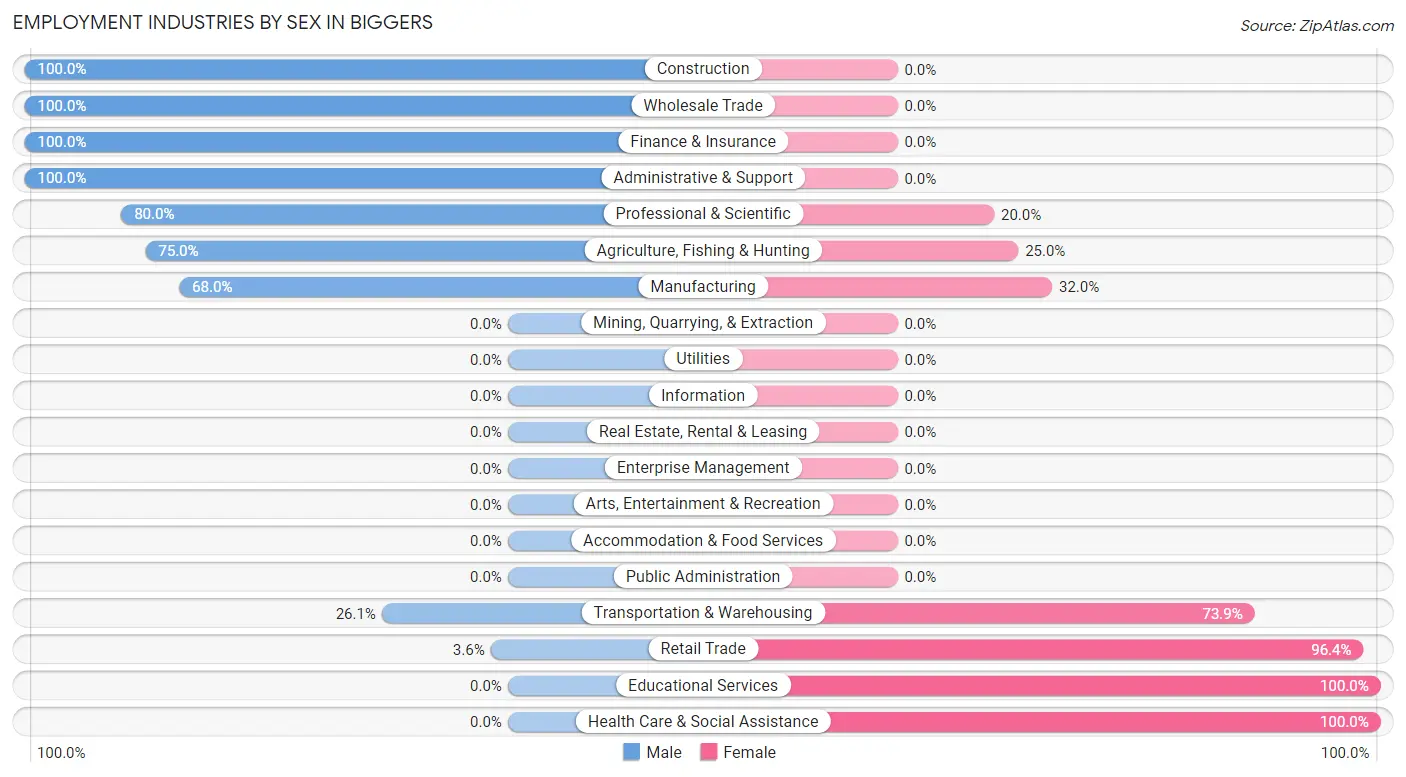
| Industry | Male | Female |
| Agriculture, Fishing & Hunting | 3 (75.0%) | 1 (25.0%) |
| Mining, Quarrying, & Extraction | 0 (0.0%) | 0 (0.0%) |
| Construction | 7 (100.0%) | 0 (0.0%) |
| Manufacturing | 17 (68.0%) | 8 (32.0%) |
| Wholesale Trade | 13 (100.0%) | 0 (0.0%) |
| Retail Trade | 2 (3.6%) | 54 (96.4%) |
| Transportation & Warehousing | 6 (26.1%) | 17 (73.9%) |
| Utilities | 0 (0.0%) | 0 (0.0%) |
| Information | 0 (0.0%) | 0 (0.0%) |
| Finance & Insurance | 4 (100.0%) | 0 (0.0%) |
| Real Estate, Rental & Leasing | 0 (0.0%) | 0 (0.0%) |
| Professional & Scientific | 4 (80.0%) | 1 (20.0%) |
| Enterprise Management | 0 (0.0%) | 0 (0.0%) |
| Administrative & Support | 2 (100.0%) | 0 (0.0%) |
| Educational Services | 0 (0.0%) | 4 (100.0%) |
| Health Care & Social Assistance | 0 (0.0%) | 17 (100.0%) |
| Arts, Entertainment & Recreation | 0 (0.0%) | 0 (0.0%) |
| Accommodation & Food Services | 0 (0.0%) | 0 (0.0%) |
| Public Administration | 0 (0.0%) | 0 (0.0%) |
| Total | 77 (43.0%) | 102 (57.0%) |
Education in Biggers
School Enrollment in Biggers
The most common levels of schooling among the 67 students in Biggers are elementary school (22 | 32.8%), nursery / preschool (19 | 28.4%), and college / undergraduate (11 | 16.4%).

| School Level | # Students | % Students |
| Nursery / Preschool | 19 | 28.4% |
| Kindergarten | 3 | 4.5% |
| Elementary School | 22 | 32.8% |
| Middle School | 4 | 6.0% |
| High School | 8 | 11.9% |
| College / Undergraduate | 11 | 16.4% |
| Graduate / Professional | 0 | 0.0% |
| Total | 67 | 100.0% |
School Enrollment by Age by Funding Source in Biggers
Out of a total of 67 students who are enrolled in schools in Biggers, 7 (10.4%) attend a private institution, while the remaining 60 (89.6%) are enrolled in public schools. The age group of 35 years and over has the highest likelihood of being enrolled in private schools, with 3 (100.0% in the age bracket) enrolled. Conversely, the age group of 5 to 9 year old has the lowest likelihood of being enrolled in a private school, with 25 (100.0% in the age bracket) attending a public institution.

| Age Bracket | Public School | Private School |
| 3 to 4 Year Olds | 18 (94.7%) | 1 (5.3%) |
| 5 to 9 Year Old | 25 (100.0%) | 0 (0.0%) |
| 10 to 14 Year Olds | 4 (100.0%) | 0 (0.0%) |
| 15 to 17 Year Olds | 5 (100.0%) | 0 (0.0%) |
| 18 to 19 Year Olds | 0 (0.0%) | 0 (0.0%) |
| 20 to 24 Year Olds | 2 (40.0%) | 3 (60.0%) |
| 25 to 34 Year Olds | 6 (100.0%) | 0 (0.0%) |
| 35 Years and over | 0 (0.0%) | 3 (100.0%) |
| Total | 60 (89.6%) | 7 (10.4%) |
Educational Attainment by Field of Study in Biggers
Liberal arts & history (18 | 50.0%), business (6 | 16.7%), social sciences (4 | 11.1%), education (4 | 11.1%), and visual & performing arts (4 | 11.1%) are the most common fields of study among 36 individuals in Biggers who have obtained a bachelor's degree or higher.
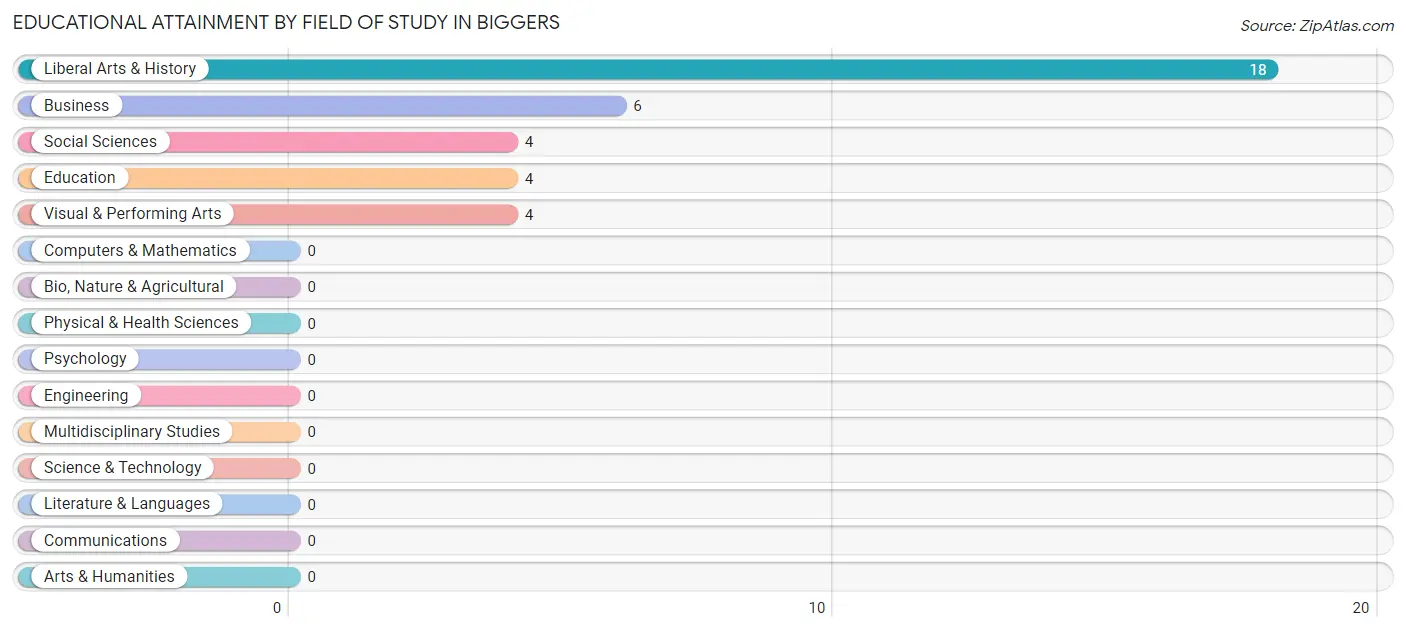
| Field of Study | # Graduates | % Graduates |
| Computers & Mathematics | 0 | 0.0% |
| Bio, Nature & Agricultural | 0 | 0.0% |
| Physical & Health Sciences | 0 | 0.0% |
| Psychology | 0 | 0.0% |
| Social Sciences | 4 | 11.1% |
| Engineering | 0 | 0.0% |
| Multidisciplinary Studies | 0 | 0.0% |
| Science & Technology | 0 | 0.0% |
| Business | 6 | 16.7% |
| Education | 4 | 11.1% |
| Literature & Languages | 0 | 0.0% |
| Liberal Arts & History | 18 | 50.0% |
| Visual & Performing Arts | 4 | 11.1% |
| Communications | 0 | 0.0% |
| Arts & Humanities | 0 | 0.0% |
| Total | 36 | 100.0% |
Transportation & Commute in Biggers
Vehicle Availability by Sex in Biggers
The most prevalent vehicle ownership categories in Biggers are males with 2 vehicles (38, accounting for 49.3%) and females with 2 vehicles (17, making up 37.2%).

| Vehicles Available | Male | Female |
| No Vehicle | 0 (0.0%) | 0 (0.0%) |
| 1 Vehicle | 8 (10.4%) | 24 (23.5%) |
| 2 Vehicles | 38 (49.3%) | 17 (16.7%) |
| 3 Vehicles | 6 (7.8%) | 59 (57.8%) |
| 4 Vehicles | 23 (29.9%) | 2 (2.0%) |
| 5 or more Vehicles | 2 (2.6%) | 0 (0.0%) |
| Total | 77 (100.0%) | 102 (100.0%) |
Commute Time in Biggers
The most frequently occuring commute durations in Biggers are 15 to 19 minutes (80 commuters, 49.7%), 25 to 29 minutes (29 commuters, 18.0%), and 20 to 24 minutes (26 commuters, 16.2%).
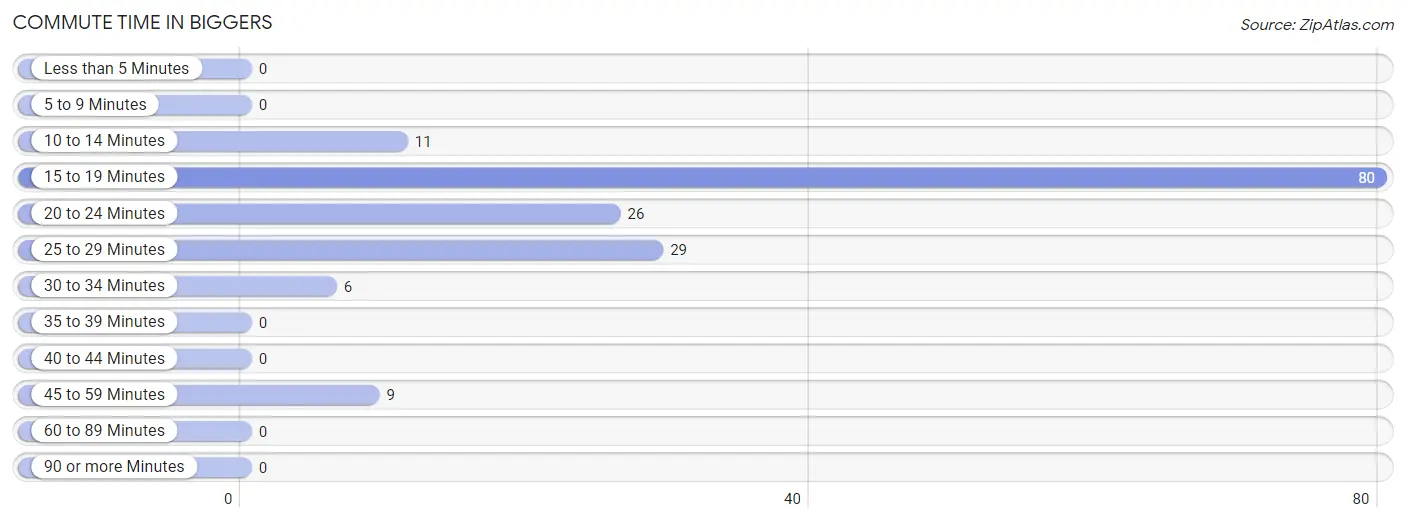
| Commute Time | # Commuters | % Commuters |
| Less than 5 Minutes | 0 | 0.0% |
| 5 to 9 Minutes | 0 | 0.0% |
| 10 to 14 Minutes | 11 | 6.8% |
| 15 to 19 Minutes | 80 | 49.7% |
| 20 to 24 Minutes | 26 | 16.2% |
| 25 to 29 Minutes | 29 | 18.0% |
| 30 to 34 Minutes | 6 | 3.7% |
| 35 to 39 Minutes | 0 | 0.0% |
| 40 to 44 Minutes | 0 | 0.0% |
| 45 to 59 Minutes | 9 | 5.6% |
| 60 to 89 Minutes | 0 | 0.0% |
| 90 or more Minutes | 0 | 0.0% |
Commute Time by Sex in Biggers
The most common commute times in Biggers are 25 to 29 minutes (19 commuters, 32.2%) for males and 15 to 19 minutes (69 commuters, 67.6%) for females.
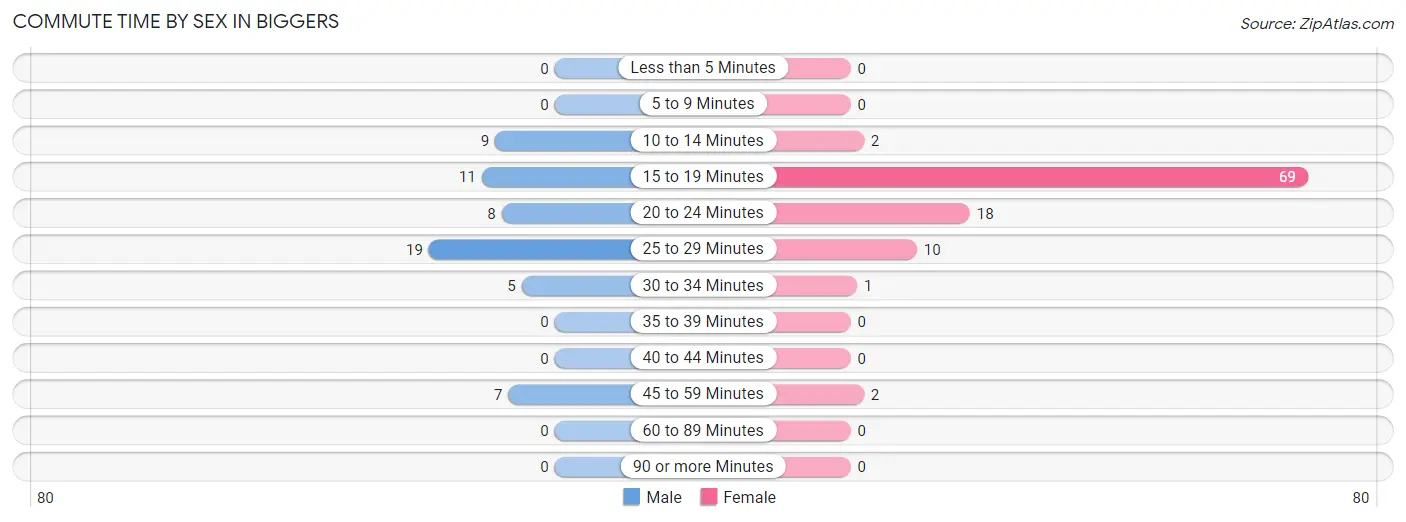
| Commute Time | Male | Female |
| Less than 5 Minutes | 0 (0.0%) | 0 (0.0%) |
| 5 to 9 Minutes | 0 (0.0%) | 0 (0.0%) |
| 10 to 14 Minutes | 9 (15.2%) | 2 (2.0%) |
| 15 to 19 Minutes | 11 (18.6%) | 69 (67.6%) |
| 20 to 24 Minutes | 8 (13.6%) | 18 (17.6%) |
| 25 to 29 Minutes | 19 (32.2%) | 10 (9.8%) |
| 30 to 34 Minutes | 5 (8.5%) | 1 (1.0%) |
| 35 to 39 Minutes | 0 (0.0%) | 0 (0.0%) |
| 40 to 44 Minutes | 0 (0.0%) | 0 (0.0%) |
| 45 to 59 Minutes | 7 (11.9%) | 2 (2.0%) |
| 60 to 89 Minutes | 0 (0.0%) | 0 (0.0%) |
| 90 or more Minutes | 0 (0.0%) | 0 (0.0%) |
Time of Departure to Work by Sex in Biggers
The most frequent times of departure to work in Biggers are 5:00 AM to 5:29 AM (22, 37.3%) for males and 12:00 PM to 3:59 PM (52, 51.0%) for females.
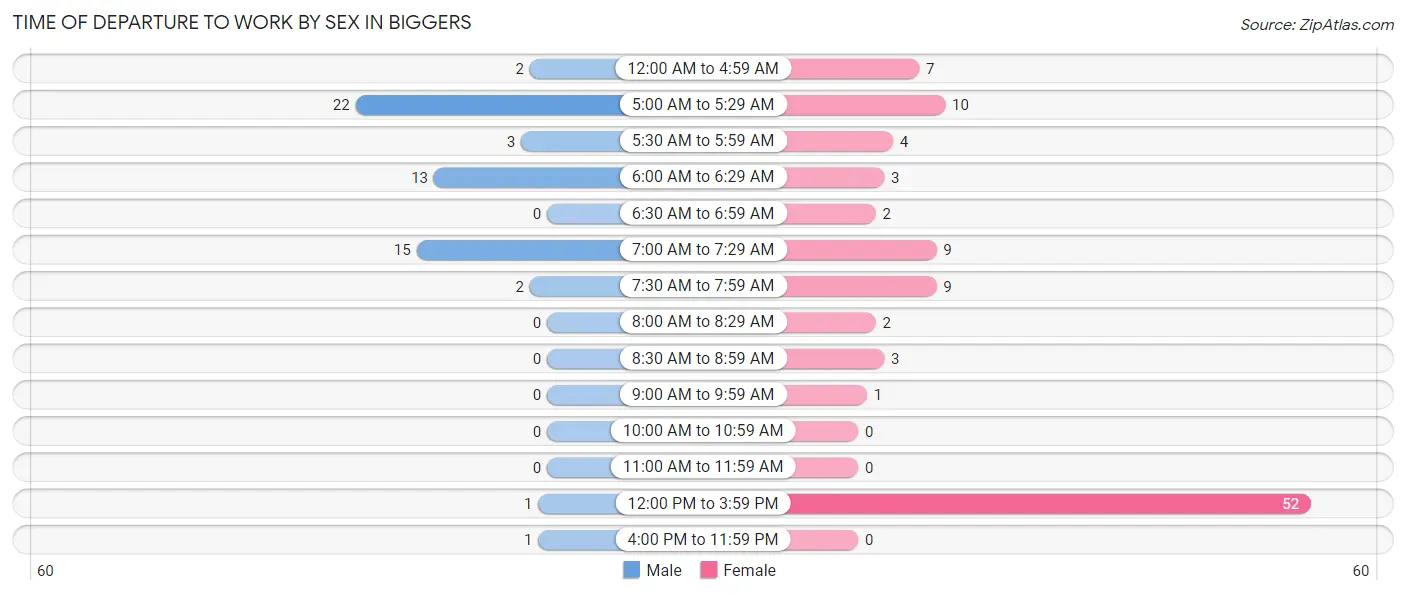
| Time of Departure | Male | Female |
| 12:00 AM to 4:59 AM | 2 (3.4%) | 7 (6.9%) |
| 5:00 AM to 5:29 AM | 22 (37.3%) | 10 (9.8%) |
| 5:30 AM to 5:59 AM | 3 (5.1%) | 4 (3.9%) |
| 6:00 AM to 6:29 AM | 13 (22.0%) | 3 (2.9%) |
| 6:30 AM to 6:59 AM | 0 (0.0%) | 2 (2.0%) |
| 7:00 AM to 7:29 AM | 15 (25.4%) | 9 (8.8%) |
| 7:30 AM to 7:59 AM | 2 (3.4%) | 9 (8.8%) |
| 8:00 AM to 8:29 AM | 0 (0.0%) | 2 (2.0%) |
| 8:30 AM to 8:59 AM | 0 (0.0%) | 3 (2.9%) |
| 9:00 AM to 9:59 AM | 0 (0.0%) | 1 (1.0%) |
| 10:00 AM to 10:59 AM | 0 (0.0%) | 0 (0.0%) |
| 11:00 AM to 11:59 AM | 0 (0.0%) | 0 (0.0%) |
| 12:00 PM to 3:59 PM | 1 (1.7%) | 52 (51.0%) |
| 4:00 PM to 11:59 PM | 1 (1.7%) | 0 (0.0%) |
| Total | 59 (100.0%) | 102 (100.0%) |
Housing Occupancy in Biggers
Occupancy by Ownership in Biggers
Of the total 170 dwellings in Biggers, owner-occupied units account for 99 (58.2%), while renter-occupied units make up 71 (41.8%).

| Occupancy | # Housing Units | % Housing Units |
| Owner Occupied Housing Units | 99 | 58.2% |
| Renter-Occupied Housing Units | 71 | 41.8% |
| Total Occupied Housing Units | 170 | 100.0% |
Occupancy by Household Size in Biggers

| Household Size | # Housing Units | % Housing Units |
| 1-Person Household | 43 | 25.3% |
| 2-Person Household | 52 | 30.6% |
| 3-Person Household | 31 | 18.2% |
| 4+ Person Household | 44 | 25.9% |
| Total Housing Units | 170 | 100.0% |
Occupancy by Ownership by Household Size in Biggers

| Household Size | Owner-occupied | Renter-occupied |
| 1-Person Household | 35 (81.4%) | 8 (18.6%) |
| 2-Person Household | 45 (86.5%) | 7 (13.5%) |
| 3-Person Household | 13 (41.9%) | 18 (58.1%) |
| 4+ Person Household | 6 (13.6%) | 38 (86.4%) |
| Total Housing Units | 99 (58.2%) | 71 (41.8%) |
Occupancy by Educational Attainment in Biggers

| Household Size | Owner-occupied | Renter-occupied |
| Less than High School | 25 (92.6%) | 2 (7.4%) |
| High School Diploma | 44 (68.8%) | 20 (31.2%) |
| College/Associate Degree | 24 (43.6%) | 31 (56.4%) |
| Bachelor's Degree or higher | 6 (25.0%) | 18 (75.0%) |
Occupancy by Age of Householder in Biggers

| Age Bracket | # Households | % Households |
| Under 35 Years | 46 | 27.1% |
| 35 to 44 Years | 12 | 7.1% |
| 45 to 54 Years | 8 | 4.7% |
| 55 to 64 Years | 19 | 11.2% |
| 65 to 74 Years | 39 | 22.9% |
| 75 to 84 Years | 37 | 21.8% |
| 85 Years and Over | 9 | 5.3% |
| Total | 170 | 100.0% |
Housing Finances in Biggers
Median Income by Occupancy in Biggers

| Occupancy Type | # Households | Median Income |
| Owner-Occupied | 99 (58.2%) | $54,063 |
| Renter-Occupied | 71 (41.8%) | $0 |
| Average | 170 (100.0%) | $0 |
Occupancy by Householder Income Bracket in Biggers
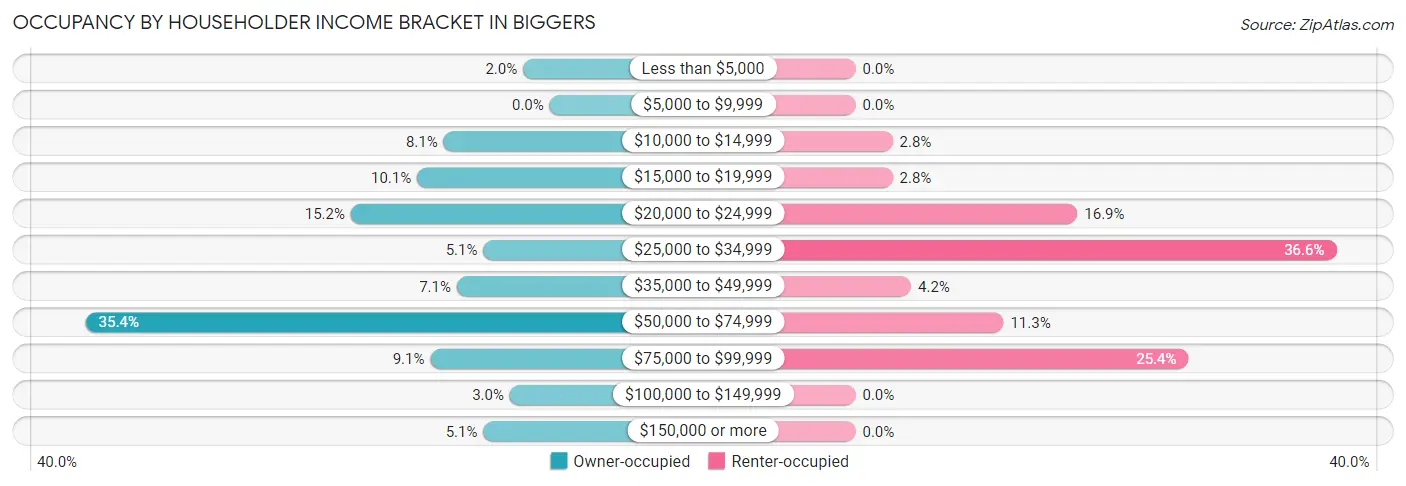
| Income Bracket | Owner-occupied | Renter-occupied |
| Less than $5,000 | 2 (2.0%) | 0 (0.0%) |
| $5,000 to $9,999 | 0 (0.0%) | 0 (0.0%) |
| $10,000 to $14,999 | 8 (8.1%) | 2 (2.8%) |
| $15,000 to $19,999 | 10 (10.1%) | 2 (2.8%) |
| $20,000 to $24,999 | 15 (15.1%) | 12 (16.9%) |
| $25,000 to $34,999 | 5 (5.1%) | 26 (36.6%) |
| $35,000 to $49,999 | 7 (7.1%) | 3 (4.2%) |
| $50,000 to $74,999 | 35 (35.3%) | 8 (11.3%) |
| $75,000 to $99,999 | 9 (9.1%) | 18 (25.4%) |
| $100,000 to $149,999 | 3 (3.0%) | 0 (0.0%) |
| $150,000 or more | 5 (5.1%) | 0 (0.0%) |
| Total | 99 (100.0%) | 71 (100.0%) |
Monthly Housing Cost Tiers in Biggers

| Monthly Cost | Owner-occupied | Renter-occupied |
| Less than $300 | 38 (38.4%) | 0 (0.0%) |
| $300 to $499 | 24 (24.2%) | 7 (9.9%) |
| $500 to $799 | 35 (35.3%) | 17 (23.9%) |
| $800 to $999 | 0 (0.0%) | 11 (15.5%) |
| $1,000 to $1,499 | 0 (0.0%) | 0 (0.0%) |
| $1,500 to $1,999 | 0 (0.0%) | 0 (0.0%) |
| $2,000 to $2,499 | 2 (2.0%) | 0 (0.0%) |
| $2,500 to $2,999 | 0 (0.0%) | 0 (0.0%) |
| $3,000 or more | 0 (0.0%) | 0 (0.0%) |
| Total | 99 (100.0%) | 71 (100.0%) |
Physical Housing Characteristics in Biggers
Housing Structures in Biggers

| Structure Type | # Housing Units | % Housing Units |
| Single Unit, Detached | 163 | 95.9% |
| Single Unit, Attached | 0 | 0.0% |
| 2 Unit Apartments | 0 | 0.0% |
| 3 or 4 Unit Apartments | 0 | 0.0% |
| 5 to 9 Unit Apartments | 0 | 0.0% |
| 10 or more Apartments | 1 | 0.6% |
| Mobile Home / Other | 6 | 3.5% |
| Total | 170 | 100.0% |
Housing Structures by Occupancy in Biggers

| Structure Type | Owner-occupied | Renter-occupied |
| Single Unit, Detached | 93 (57.1%) | 70 (42.9%) |
| Single Unit, Attached | 0 (0.0%) | 0 (0.0%) |
| 2 Unit Apartments | 0 (0.0%) | 0 (0.0%) |
| 3 or 4 Unit Apartments | 0 (0.0%) | 0 (0.0%) |
| 5 to 9 Unit Apartments | 0 (0.0%) | 0 (0.0%) |
| 10 or more Apartments | 0 (0.0%) | 1 (100.0%) |
| Mobile Home / Other | 6 (100.0%) | 0 (0.0%) |
| Total | 99 (58.2%) | 71 (41.8%) |
Housing Structures by Number of Rooms in Biggers

| Number of Rooms | Owner-occupied | Renter-occupied |
| 1 Room | 2 (2.0%) | 0 (0.0%) |
| 2 or 3 Rooms | 0 (0.0%) | 1 (1.4%) |
| 4 or 5 Rooms | 28 (28.3%) | 31 (43.7%) |
| 6 or 7 Rooms | 65 (65.7%) | 21 (29.6%) |
| 8 or more Rooms | 4 (4.0%) | 18 (25.4%) |
| Total | 99 (100.0%) | 71 (100.0%) |
Housing Structure by Heating Type in Biggers

| Heating Type | Owner-occupied | Renter-occupied |
| Utility Gas | 76 (76.8%) | 68 (95.8%) |
| Bottled, Tank, or LP Gas | 9 (9.1%) | 0 (0.0%) |
| Electricity | 6 (6.1%) | 1 (1.4%) |
| Fuel Oil or Kerosene | 0 (0.0%) | 0 (0.0%) |
| Coal or Coke | 0 (0.0%) | 0 (0.0%) |
| All other Fuels | 8 (8.1%) | 2 (2.8%) |
| No Fuel Used | 0 (0.0%) | 0 (0.0%) |
| Total | 99 (100.0%) | 71 (100.0%) |
Household Vehicle Usage in Biggers

| Vehicles per Household | Owner-occupied | Renter-occupied |
| No Vehicle | 7 (7.1%) | 0 (0.0%) |
| 1 Vehicle | 27 (27.3%) | 27 (38.0%) |
| 2 Vehicles | 24 (24.2%) | 26 (36.6%) |
| 3 or more Vehicles | 41 (41.4%) | 18 (25.4%) |
| Total | 99 (100.0%) | 71 (100.0%) |
Real Estate & Mortgages in Biggers
Real Estate and Mortgage Overview in Biggers
| Characteristic | Without Mortgage | With Mortgage |
| Housing Units | 86 | 13 |
| Median Property Value | $53,700 | $47,900 |
| Median Household Income | $65,000 | $2 |
| Monthly Housing Costs | $380 | $0 |
| Real Estate Taxes | $393 | $4 |
Property Value by Mortgage Status in Biggers

| Property Value | Without Mortgage | With Mortgage |
| Less than $50,000 | 32 (37.2%) | 8 (61.5%) |
| $50,000 to $99,999 | 48 (55.8%) | 5 (38.5%) |
| $100,000 to $299,999 | 6 (7.0%) | 0 (0.0%) |
| $300,000 to $499,999 | 0 (0.0%) | 0 (0.0%) |
| $500,000 to $749,999 | 0 (0.0%) | 0 (0.0%) |
| $750,000 to $999,999 | 0 (0.0%) | 0 (0.0%) |
| $1,000,000 or more | 0 (0.0%) | 0 (0.0%) |
| Total | 86 (100.0%) | 13 (100.0%) |
Household Income by Mortgage Status in Biggers

| Household Income | Without Mortgage | With Mortgage |
| Less than $10,000 | 2 (2.3%) | 0 (0.0%) |
| $10,000 to $24,999 | 29 (33.7%) | 0 (0.0%) |
| $25,000 to $34,999 | 2 (2.3%) | 4 (30.8%) |
| $35,000 to $49,999 | 5 (5.8%) | 3 (23.1%) |
| $50,000 to $74,999 | 34 (39.5%) | 2 (15.4%) |
| $75,000 to $99,999 | 9 (10.5%) | 1 (7.7%) |
| $100,000 to $149,999 | 2 (2.3%) | 0 (0.0%) |
| $150,000 or more | 3 (3.5%) | 1 (7.7%) |
| Total | 86 (100.0%) | 13 (100.0%) |
Property Value to Household Income Ratio in Biggers

| Value-to-Income Ratio | Without Mortgage | With Mortgage |
| Less than 2.0x | 62 (72.1%) | 34,375 (264,423.1%) |
| 2.0x to 2.9x | 5 (5.8%) | 7 (53.8%) |
| 3.0x to 3.9x | 16 (18.6%) | 3 (23.1%) |
| 4.0x or more | 2 (2.3%) | 1 (7.7%) |
| Total | 86 (100.0%) | 13 (100.0%) |
Real Estate Taxes by Mortgage Status in Biggers

| Property Taxes | Without Mortgage | With Mortgage |
| Less than $800 | 57 (66.3%) | 0 (0.0%) |
| $800 to $1,499 | 0 (0.0%) | 9 (69.2%) |
| $800 to $1,499 | 6 (7.0%) | 0 (0.0%) |
| Total | 86 (100.0%) | 13 (100.0%) |
Health & Disability in Biggers
Health Insurance Coverage by Age in Biggers

| Age Bracket | With Coverage | Without Coverage |
| Under 6 Years | 63 (100.0%) | 0 (0.0%) |
| 6 to 18 Years | 41 (100.0%) | 0 (0.0%) |
| 19 to 25 Years | 42 (95.5%) | 2 (4.5%) |
| 26 to 34 Years | 55 (93.2%) | 4 (6.8%) |
| 35 to 44 Years | 42 (100.0%) | 0 (0.0%) |
| 45 to 54 Years | 10 (90.9%) | 1 (9.1%) |
| 55 to 64 Years | 82 (96.5%) | 3 (3.5%) |
| 65 to 74 Years | 70 (100.0%) | 0 (0.0%) |
| 75 Years and older | 51 (100.0%) | 0 (0.0%) |
| Total | 456 (97.9%) | 10 (2.1%) |
Health Insurance Coverage by Citizenship Status in Biggers

| Citizenship Status | With Coverage | Without Coverage |
| Native Born | 63 (100.0%) | 0 (0.0%) |
| Foreign Born, Citizen | 41 (100.0%) | 0 (0.0%) |
| Foreign Born, not a Citizen | 42 (95.5%) | 2 (4.5%) |
Health Insurance Coverage by Household Income in Biggers

| Household Income | With Coverage | Without Coverage |
| Under $25,000 | 116 (97.5%) | 3 (2.5%) |
| $25,000 to $49,999 | 106 (99.1%) | 1 (0.9%) |
| $50,000 to $74,999 | 144 (99.3%) | 1 (0.7%) |
| $75,000 to $99,999 | 68 (100.0%) | 0 (0.0%) |
| $100,000 and over | 22 (81.5%) | 5 (18.5%) |
Public vs Private Health Insurance Coverage by Age in Biggers

| Age Bracket | Public Insurance | Private Insurance |
| Under 6 | 63 (100.0%) | 2 (3.2%) |
| 6 to 18 Years | 39 (95.1%) | 2 (4.9%) |
| 19 to 25 Years | 28 (63.6%) | 16 (36.4%) |
| 25 to 34 Years | 34 (57.6%) | 21 (35.6%) |
| 35 to 44 Years | 17 (40.5%) | 27 (64.3%) |
| 45 to 54 Years | 8 (72.7%) | 2 (18.2%) |
| 55 to 64 Years | 13 (15.3%) | 70 (82.4%) |
| 65 to 74 Years | 62 (88.6%) | 20 (28.6%) |
| 75 Years and over | 51 (100.0%) | 39 (76.5%) |
| Total | 315 (67.6%) | 199 (42.7%) |
Disability Status by Sex by Age in Biggers

| Age Bracket | Male | Female |
| Under 5 Years | 0 (0.0%) | 0 (0.0%) |
| 5 to 17 Years | 2 (9.1%) | 2 (9.5%) |
| 18 to 34 Years | 27 (49.1%) | 12 (21.8%) |
| 35 to 64 Years | 17 (36.2%) | 21 (23.1%) |
| 65 to 74 Years | 27 (81.8%) | 4 (10.8%) |
| 75 Years and over | 28 (93.3%) | 3 (14.3%) |
Disability Class by Sex by Age in Biggers
Disability Class: Hearing Difficulty

| Age Bracket | Male | Female |
| Under 5 Years | 0 (0.0%) | 0 (0.0%) |
| 5 to 17 Years | 0 (0.0%) | 0 (0.0%) |
| 18 to 34 Years | 0 (0.0%) | 2 (3.6%) |
| 35 to 64 Years | 0 (0.0%) | 0 (0.0%) |
| 65 to 74 Years | 27 (81.8%) | 0 (0.0%) |
| 75 Years and over | 28 (93.3%) | 0 (0.0%) |
Disability Class: Vision Difficulty

| Age Bracket | Male | Female |
| Under 5 Years | 0 (0.0%) | 0 (0.0%) |
| 5 to 17 Years | 0 (0.0%) | 2 (9.5%) |
| 18 to 34 Years | 3 (5.4%) | 0 (0.0%) |
| 35 to 64 Years | 0 (0.0%) | 3 (3.3%) |
| 65 to 74 Years | 2 (6.1%) | 0 (0.0%) |
| 75 Years and over | 2 (6.7%) | 0 (0.0%) |
Disability Class: Cognitive Difficulty

| Age Bracket | Male | Female |
| 5 to 17 Years | 2 (9.1%) | 0 (0.0%) |
| 18 to 34 Years | 27 (49.1%) | 5 (9.1%) |
| 35 to 64 Years | 16 (34.0%) | 13 (14.3%) |
| 65 to 74 Years | 3 (9.1%) | 3 (8.1%) |
| 75 Years and over | 0 (0.0%) | 0 (0.0%) |
Disability Class: Ambulatory Difficulty

| Age Bracket | Male | Female |
| 5 to 17 Years | 0 (0.0%) | 0 (0.0%) |
| 18 to 34 Years | 0 (0.0%) | 0 (0.0%) |
| 35 to 64 Years | 15 (31.9%) | 5 (5.5%) |
| 65 to 74 Years | 20 (60.6%) | 4 (10.8%) |
| 75 Years and over | 0 (0.0%) | 3 (14.3%) |
Disability Class: Self-Care Difficulty

| Age Bracket | Male | Female |
| 5 to 17 Years | 0 (0.0%) | 0 (0.0%) |
| 18 to 34 Years | 0 (0.0%) | 0 (0.0%) |
| 35 to 64 Years | 0 (0.0%) | 3 (3.3%) |
| 65 to 74 Years | 0 (0.0%) | 3 (8.1%) |
| 75 Years and over | 0 (0.0%) | 2 (9.5%) |
Technology Access in Biggers
Computing Device Access in Biggers

| Device Type | # Households | % Households |
| Desktop or Laptop | 84 | 49.4% |
| Smartphone | 117 | 68.8% |
| Tablet | 66 | 38.8% |
| No Computing Device | 42 | 24.7% |
| Total | 170 | 100.0% |
Internet Access in Biggers

| Internet Type | # Households | % Households |
| Dial-Up Internet | 0 | 0.0% |
| Broadband Home | 55 | 32.4% |
| Cellular Data Only | 51 | 30.0% |
| Satellite Internet | 6 | 3.5% |
| No Internet | 59 | 34.7% |
| Total | 170 | 100.0% |
Biggers Summary
Biggers is a small town located in Randolph County, Arkansas. It is situated in the Ozark Mountains, approximately 20 miles south of Pocahontas. The town was founded in 1883 and was named after the Biggers family, who were early settlers in the area. The population of Biggers was estimated to be around 200 people in 2020.
History
Biggers was founded in 1883 by the Biggers family, who were early settlers in the area. The town was originally known as Biggersville, but the name was changed to Biggers in 1887. The town was incorporated in 1891.
Biggers was a thriving agricultural community in the early 20th century. The town was home to several cotton gins, a sawmill, and a gristmill. The town also had a post office, a bank, and a hotel.
In the late 20th century, Biggers experienced a decline in population as many of its residents moved away in search of better economic opportunities. The town's population decreased from a peak of around 500 in the 1950s to around 200 in 2020.
Geography
Biggers is located in the Ozark Mountains of Randolph County, Arkansas. The town is situated on the banks of the Black River, approximately 20 miles south of Pocahontas. The town is surrounded by rolling hills and forests.
The climate in Biggers is humid subtropical, with hot summers and mild winters. The average annual temperature is around 64°F (18°C). The average annual precipitation is around 45 inches (114 cm).
Economy
The economy of Biggers is largely based on agriculture. The town is home to several farms that produce corn, soybeans, and cotton. The town also has a sawmill and a gristmill.
The town is also home to several small businesses, including a grocery store, a hardware store, and a restaurant.
Demographics
The population of Biggers was estimated to be around 200 people in 2020. The town is predominantly white, with a small African American population. The median household income in Biggers is around $30,000. The town has a poverty rate of around 20%.
Education
Biggers is served by the Biggers-Reyno School District. The district operates one elementary school and one high school. The town also has a public library.
Common Questions
What is Per Capita Income in Biggers?
Per Capita income in Biggers is $22,250.
What is the Median Family Income in Biggers?
Median Family Income in Biggers is $66,250.
What is Income or Wage Gap in Biggers?
Income or Wage Gap in Biggers is 7.1%.
Women in Biggers earn 92.9 cents for every dollar earned by a man.
What is Inequality or Gini Index in Biggers?
Inequality or Gini Index in Biggers is 0.37.
What is the Total Population of Biggers?
Total Population of Biggers is 466.
What is the Total Male Population of Biggers?
Total Male Population of Biggers is 216.
What is the Total Female Population of Biggers?
Total Female Population of Biggers is 250.
What is the Ratio of Males per 100 Females in Biggers?
There are 86.40 Males per 100 Females in Biggers.
What is the Ratio of Females per 100 Males in Biggers?
There are 115.74 Females per 100 Males in Biggers.
What is the Median Population Age in Biggers?
Median Population Age in Biggers is 39.7 Years.
What is the Average Family Size in Biggers
Average Family Size in Biggers is 3.2 People.
What is the Average Household Size in Biggers
Average Household Size in Biggers is 2.7 People.
How Large is the Labor Force in Biggers?
There are 197 People in the Labor Forcein in Biggers.
What is the Percentage of People in the Labor Force in Biggers?
52.7% of People are in the Labor Force in Biggers.
What is the Unemployment Rate in Biggers?
Unemployment Rate in Biggers is 9.1%.